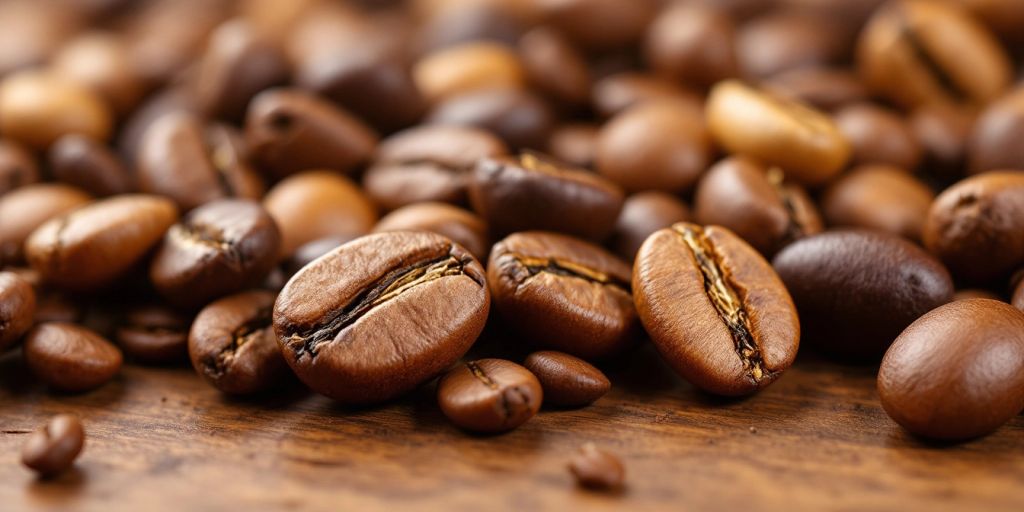Understanding Coffee Bean Varieties
When it comes to coffee, knowing the different types of beans is key to brewing the perfect cup. There are two main types of coffee beans: Arabica and Robusta. Each has its own unique flavor and characteristics that can change your coffee experience.
Arabica vs. Robusta
- Arabica beans are known for their smooth, sweet taste and higher acidity. They make up about 60-70% of the world’s coffee production. These beans thrive in high altitudes and are more sensitive to pests.
- Robusta beans, on the other hand, are stronger and more bitter, with a higher caffeine content. They are easier to grow and are often used in espresso blends for that extra kick.
| Type | Flavor Profile | Caffeine Content | Growing Regions |
|---|---|---|---|
| Arabica | Sweet, fruity, floral notes | ~1.5% | Latin America, Eastern Africa |
| Robusta | Strong, bitter, earthy notes | ~2.7% | Africa, Indonesia, Vietnam |
Lesser-Known Varieties
While Arabica and Robusta are the stars, there are lesser-known varieties like Liberica and Excelsa. These beans offer unique flavors and are worth exploring for adventurous coffee lovers.
How Varieties Affect Flavor
The type of coffee bean you choose can greatly influence your coffee’s flavor. If you want a smooth cup, go for Arabica. If you prefer a bold, strong taste, Robusta is your best bet. Understanding these differences is essential for how to choose coffee beans that suit your taste.
Choosing the right coffee bean is like picking the right ingredient for a recipe; it can make all the difference in the final product!
Exploring Coffee Bean Origins
Coffee beans are not just beans; they are a journey through different lands! Each region offers its own unique flavors and characteristics. Understanding where your coffee comes from can elevate your coffee experience.
Popular Coffee Growing Regions
- Colombia: Known for its smooth, nutty flavor and mild acidity.
- Ethiopia: Famous for its fruity and floral notes, often with a wine-like quality.
- Brazil: Offers chocolatey and nutty flavors, perfect for espresso blends.
How Origin Influences Flavor
The origin of coffee beans plays a huge role in their taste. Factors like altitude, soil, and climate shape the beans’ flavor profiles. For example:
- High-altitude beans tend to have a richer flavor.
- Low-altitude beans may taste more earthy and less complex.
Single-Origin vs. Blends
- Single-Origin: Coffee from one specific region, showcasing unique flavors.
- Blends: A mix of beans from different origins, creating a balanced flavor.
Coffee is all about coffee; it’s a blend of art, science, and culture. Each cup tells a story of its origin, making every sip a delightful experience.
Understanding these origins can help you choose the perfect coffee for your taste buds!
The Importance of Roast Levels
When it comes to coffee, the roast level can make or break your cup. Understanding the different roast levels helps you find the perfect flavor that suits your taste. Here’s a quick breakdown:
Light Roast
- Light brown color
- Retains most original flavors
- Bright and acidic, with a hint of sweetness
Medium Roast
- Balanced flavor profile
- Less acidity than light roasts
- Often a crowd-pleaser, appealing to many coffee drinkers
Dark Roast
- Bold and robust flavor
- Shiny, dark brown appearance
- Less acidic, perfect for those who love strong coffee
| Roast Level | Flavor Profile | Acidity | Caffeine Content |
|---|---|---|---|
| Light | Bright, fruity | High | Highest |
| Medium | Balanced | Medium | Medium |
| Dark | Bold, bitter | Low | Lower |
Choosing the right roast can elevate your coffee experience, making each sip a delight.
Whether you’re brewing espresso or a pour-over, the roast level plays a crucial role in the final taste. So, next time you pick up a bag of beans, remember that the roast level is your key to unlocking a world of flavors!
Choosing Coffee Beans Based on Brewing Method
When it comes to brewing coffee, the method you choose can make a big difference in flavor. Here’s how to select the right beans for your favorite brewing styles:
Espresso
For espresso lovers, the right beans are crucial. Look for:
- Dark roasts for a rich, bold flavor.
- Beans that create a good crema.
- A full-bodied taste that stands up to the brewing process.
Pour-Over and Drip
If you prefer pour-over or drip coffee, opt for:
- Medium to light roasts to highlight subtle flavors.
- Single-origin beans for a pure taste experience.
- A grind that’s not too fine to avoid over-extraction.
French Press and Cold Brew
For those who enjoy French press or cold brew, consider:
- Coarse ground beans for a smoother brew.
- Medium to dark roasts for a rich, satisfying taste.
- Beans that are dense-bodied to withstand longer brewing times.
Exploring different brewing methods can unlock new flavors in your coffee. Don’t hesitate to experiment!
In summary, your brewing method should guide your choice of coffee beans. Whether you’re going for a strong espresso or a smooth cold brew, the right beans will elevate your coffee experience. Enjoy the journey of discovering your perfect cup!
Factors Influencing Coffee Bean Flavor

When it comes to coffee, the flavor is everything! Several key factors play a role in shaping the taste of your brew. Understanding these elements can elevate your coffee experience.
Altitude
The altitude at which coffee is grown significantly impacts its flavor. Higher elevations often produce beans with a richer taste. Here’s why:
- Slow Maturation: Beans grown at high altitudes mature slowly, absorbing more sugars and acids.
- Flavor Complexity: This leads to a more complex and enjoyable flavor profile.
Soil and Climate
The terroir—or the unique environmental conditions—of a coffee-growing region affects its taste. Consider these aspects:
- Soil Composition: Different minerals can enhance or alter flavors.
- Climate Variability: Temperature and rainfall patterns influence the growth cycle and flavor development.
Processing Methods
How coffee beans are processed after harvesting also matters. Here are the main methods:
- Natural (Dry) Processing: Beans dried in their fruit, resulting in a sweet and fruity flavor.
- Washed Processing: Removes the fruit before drying, leading to a cleaner taste.
- Semi-Washed Processing: A balance between the two, offering a unique flavor profile.
Understanding these factors can help you choose the right beans for your taste preferences. The journey of coffee from farm to cup is filled with nuances that can enhance your enjoyment!
How to Store Coffee Beans Properly

Storing your coffee beans correctly is essential for keeping them fresh and flavorful. Proper storage can make all the difference! Here are some key tips to ensure your beans stay at their best:
Best Storage Practices
- Use airtight containers: This prevents air from getting in and causing oxidation.
- Keep them in a cool, dark place: A kitchen cupboard away from sunlight is ideal.
- Avoid refrigeration: Storing beans in the fridge can lead to moisture and unwanted odors.
Common Mistakes to Avoid
- Storing in clear containers: Light can degrade the quality of your beans.
- Buying in bulk: Only buy what you can consume within a month to ensure freshness.
- Grinding too much at once: Grind only what you need to maintain flavor.
Impact of Storage on Flavor
The way you store your coffee beans can significantly affect their taste. Beans stored improperly can become stale and lose their unique flavors.
Remember, the ideal temperature range for coffee storage is between 50 and 70 degrees Fahrenheit. Keeping your beans in this range will help preserve their delicious taste!
Tasting Coffee Like a Pro
Coffee tasting, often called cupping, is an exciting way to explore the flavors of your favorite brew. It’s not just about drinking coffee; it’s about experiencing it! Here’s how to get started:
The Cupping Process
- Sniff the Coffee: Take a moment to inhale the aroma. This is where the journey begins!
- Take a Sip: Let the coffee cover your entire palate. Feel the texture and taste.
- Identify Flavors: As the coffee cools, notice how the flavors change. What do you taste?
Identifying Flavor Notes
When tasting coffee, look for these common flavor notes:
- Fruity: Citrus, berry, or stone fruit flavors.
- Nutty: Almonds, hazelnuts, or peanuts.
- Chocolatey: Dark chocolate or cocoa notes.
Developing Your Palate
To become a pro at tasting coffee, practice is key. Here are some tips:
- Try Different Beans: Experiment with various origins and roast levels.
- Take Notes: Write down your impressions to track your preferences.
- Join a Tasting Group: Share experiences and learn from others.
Tasting coffee is a journey of discovery. Each cup tells a story, revealing the unique characteristics of the beans and their origins. Embrace the adventure with every sip!
By mastering the art of tasting, you’ll appreciate the nuances of your coffee even more. So grab your favorite brew and start your tasting journey today!
Want to enjoy coffee like a true expert? Dive into our guide and learn the secrets of tasting coffee like a pro! Visit our website for tips, tricks, and more to elevate your coffee experience. Don’t miss out!



